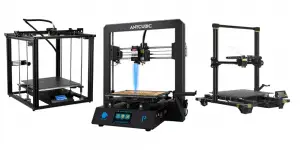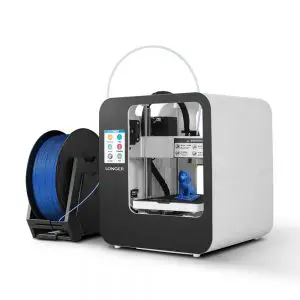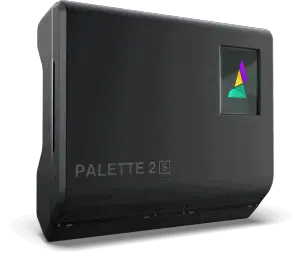If you’re in a rush and just want to know what the best budget 3D printer is, then we recommend Comgrow Creality Ender 3as the best one.





Looking For A Good Cheap 3D Printer?
Thinking over the possibilities 3D printing avails to those who use it is enough to get anyone interested in the field. However, delving into any new technology requires time and money. There can be some pitfalls while you learn your way through the 3D printing world, and trying to find the best inexpensive 3D printer is one of them. Regardless of whether you’re a complete novice or an experienced hobbyist, there are a few things you should consider when looking for your first cheap 3D printer.
What To Look For In A Cheap 3D Printer
It’s only right that you consider the cost of a 3D printer first. Buying a budget 3D printer doesn’t mean you’ll forego quality and performance. Several models under $300 will give you similar features you would expect in higher-end printers.
On the other hand, what many luxury models give you is the option to plug-and-play. Unboxing your 3D printer to see a bunch of parts can be discouraging if you’re a beginner. The upside to putting it together is the opportunity to develop a better understanding of how the machine works. Knowing how the parts fit together will help you troubleshoot any issues you may run into later. Some of the best cheap 3D printers won’t take too long to put together, many averaging an assembly time of 30 minutes or longer.
Referencing back to learning how the machine is put together, you should also take into consideration the slicer software required to create your projects. Some slicer software is are great tools for beginners to learn how to craft and print 3D builds. Here are a few of the programs to look into and see if your printer will support it:
Software Programs to Consider for your 3D Printer
Beginner
- TinkerCAD
- Cura
- MatterControl 2.0
Intermediate
- KiSSlicer
- Slic3r
- Repetier-Host
Advanced
- MeshLab
- Blender
- OnShape
Once you’ve mastered the software, you’ll want a printer that can build as fast as you can learn. The build speed and volume can differ drastically among printers. Of course, faster doesn’t always mean better. You’ll want a printer that can build your creations at a reasonable speed, give you enough room to complete the build and operate at a decent noise level.
Finding a budget 3D printer that prints quietly with a big enough build area will be difficult enough. When you begin to factor in the kinds of materials these printers can use, it seems like a neverending list of details and settings you need to know to move forward. The build materials, widely known as filaments, come in a variety of colors and chemical properties. Here are the more popular filament types you’ll see:
Popular Types of Filament for 3D Printers
PLA (Polylactic Acid)
An Eco-friendly filament vegetable-based plastic material which often uses cornstarch as it’s raw base material. Relatively odorless.
Used to make:
- Food containers
- Candy wrappers
- Prototype parts
- Biodegradable medical implants
Common Printer Settings:
- Printing Temperature: 190 – 230 degrees Celsius
- Bed Temperature: 60 – 80 degrees Celsius
ABS (acrylonitrile butadiene styrene)
Great for making parts to withstand higher temperatures, easy to print with and it makes a strong plastic
Used to make:
- Making Legos
- Objects that might be dropped
- Knife handles
- Toys
Common Printer Settings:
- Printing Temperature: 210 – 250 degrees Celsius
- Bed Temperature: 80 – 110 degrees Celsius
PETG
Durable and odorless prints. There’s a low chance for warping and it’s not brittle once dry.
Used to make:
- Cups
- Plates
- Phone cases
- Mechanical parts that require some flexibility
Common Printer Settings:
- Printing Temperature: 220 – 245 degrees Celsius
- Bed Temperature: 70 – 75 degrees Celsius
HIPS
Low-cost biodegradable filament
Used to make:
- Costumes
- Models
- Prototyping
- Figurines
Common Printer Settings:
- Printing Temperature: 220 – 230 degrees Celsius
- Bed Temperature: 50 – 60 degrees Celsius
Metal
Highly durable with very low shrinkage as the build cools
Used to make:
- Jewelry
- Home hardware
- Artifact replicas
- Statues
Common Printer Settings:
- Printing Temperature: 195 – 220 degrees Celsius
- Bed Temperature: 50 degrees Celsius
Wood
Wood fibers are added into PLA to create a filament that smells and feels like actual wood.
Used to make:
- Wooden boxes
- Tables
- Chairs
- Characters like Groot
Common Printer Settings:
- Printing Temperature: 200 -260 degrees Celsius
- Bed Temperature: 90 – 110 degrees Celsius
Nylon
This filament is strong, durable, lightweight, thermoplastic, flexible and wear-resistant.
Used to make:
- Machine parts
- Gears and bearings
- Containers
- Tools
Common Printer Settings:
- Printing Temperature: 210 – 250 degrees Celsius
- Bed Temperature: 60 – 80 degrees Celsius
TPE
Flexible printing material meant to resist abrasions and remain durable
Used to make:
- Toys
- Visual products
- Phone cases
- Novelty items
Common Printer Settings:
- Printing Temperature: 210 – 225 degrees Celsius
- Bed Temperature: 20 – 55 degrees Celsius
Heated Print Bed?
Choosing the right filament for your printer and the build is only part of the process. You’ll need to look at the print bed to determine if the filament you want to use is compatible. If the bed isn’t heated, that eliminates a few of the filaments listed above as they need both the print bed and the extruder to be at a certain temperature for the best quality prints.
Calibration
Another essential part of the build process is calibrating the printer. A few of the best cheap 3D printers have assisted leveling, but be prepared to manually adjust the print bed and its axis. Learning how to do this is important so your build layers don’t warp or shift during the build.
Overall, the factors you need to consider are the price, assembly time, the software needed to operate the machine, types of compatible filament and how easy the machine is to learn and use.
Best Inexpensive 3D Printer: Comparing Our Top 5
Comgrow Creality Ender 3
This compact printer has a decent build volume of 220 mm x 220 mm x 250 mm. There’s a power loss recovery option along with manual bed leveling. The printer allows for the use of multiple kinds of filaments to produce high quality builds. The assembly is straightforward and comes with extra nozzles in the packaging.
Pros:
- Max nozzle temp: 255 degrees Celsius
- Max heat bed temp: 110 degrees Celsius
- Max print speed: 180 mm per second
- High-quality prints
- Easy assembly
- Tethered or untethered operation
- Open source for software with a lot of upgrades available
Cons:
- The base is slightly uneven making it difficult to level
- Manual calibration takes time to learn
- Extra adhesion needed for exotic filaments
ANYCUBIC MEGA i3
This printer is built for durability with the power loss recovery feature and a filament sensor. Using the extra fine print option will yield stunning and near-flawless results. The build volume is pretty average at 210 mm x 210 mm x 205 mm. The assembly is extensive but can be completed within an hour.
Pros:
- Max nozzle temp: 260 degrees Celsius
- Max heat bed temp: 100 degrees Celsius
- Best print speed: 60 mm per second
- Clear instructions and user guides with a responsive touchscreen
- Takes a variety of filament types: PLA, ABS, HIPS, & Wood
Cons:
- Noisy printing
- Not mod- or upgrade-friendly
- Semi-automatic bed leveling is advertised as fully automatic
Da Vinci Mini 3D Printer
This colorful printer looks like a toy and is heavily geared toward the more youthful beginner. Its software offers guides on how to use the machine, how to build files, STEM education and the overall printing process. Its small build volume, 149 mm x 149 mm x 149 mm, doesn’t allow for larger pieces and it only uses proprietary filaments which limits your creativity as well. The assembly is straightforward in that there is none. It is one of the few budget printers to be a plug-and-play right out of the box.
Pros:
- Free and easy software to use
- Child-friendly
- Quiet printing
- Automatic calibration
Cons:
- Subpar printing quality
- Proprietary filaments only
- Small build volume
- Non-heated print bed
- Must be tethered to the computer to work
JGMaker Magic 3D
This printer comes equipped with a filament runout sensor and a removable print bed. The build volume is substantial at 220 mm x 220 mm x 250 mm. The frame is sturdy and only takes about 10 minutes to assemble out of the box. The heated print bed provides good adhesion for the assortment of filaments compatible with the printer. It’s able to print with PLA, ABS, TPU and Wood.
Pros:
- Max nozzle temp: 250 degrees Celsius
- Max heat bed temp: 110 degrees Celsius
- Max print speed: 150 mm per second
- Decent build volume
- Easy to assemble
- Power loss recovery and a filament sensor
Cons:
- Manual leveling can take a while to get right
- Parts included aren’t always quality tested and sometimes don’t fit preventing it from being completely assembled
- Takes some time to learn the ins and outs of this machine
Kingroon 3D Printer
A partially enclosed build area is a great asset to this printer, especially when it prints with filaments like ABS. There is a sensor to let you know when the filament is running low and a power loss resume sensor too. A spare nozzle comes with the package. The printer is built tough with an okay build area of 200 mm x 200 mm x 210 mm. The company claims that the heated print bed and nozzle allow for any filament by any manufacturer to be used. Filaments like PLA, ABS and PETG can be used.
Pros:
- Max nozzle temp: 255 degrees Celsius
- Max heat bed temp: 150 degrees Celsius
- Best print speed: 60 mm per second
- Comes fully assembled and calibrated in the box
- Heated glass print bed
Cons:
- Assisted bed leveling, but luckily it comes leveled already so you might not have to play around with this feature
- There’s no control over the part cooling fan. It cools the build area and the hot end simultaneously which is great for PLA but not other filaments.
- You have to print slow, like 10 mm per second slow, for smaller objects
Our Top Pick
While any of these printers would be a great option to tinker around with. The best inexpensive 3D printer for 2019 is the Comgrow Creality Ender 3. An open-source printer with the capability to print with exotic filaments makes for a great introduction into the 3D printing industry. Even if you’re not a complete beginner, an experienced hobbyist will find this machine reliable and worth a try for the low price.
Last update on 2025-05-30 / Affiliate links / Images from Amazon Product Advertising API









